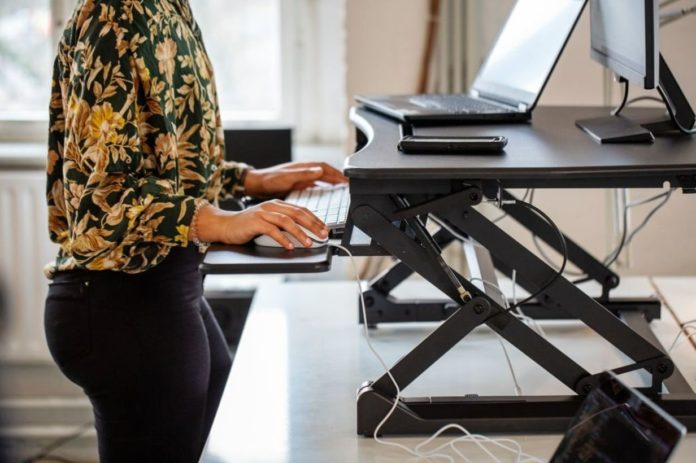A standing desk or height-adjustable workstations can cut down on daily sitting time by more than an hour and also improves workers’ stress levels, well-being, and energy levels at work.
Using a standing desk combined with a package of other strategies to encourage office workers to sit less and exercise more reduced sitting time by almost one hour per day over the course of one year, according to a study published today in The BMJ.
These indicators were also associated with modest improvements in work-related stress, well-being, and energy levels, but the researchers emphasize that these changes were not clinically significant.
There is more and more evidence that sedentary lifestyles are linked to higher rates of depression and anxiety as well as chronic diseases like heart disease, type 2 diabetes, and some cancers.
Office workers are one of the most sedentary demographics, spending 73% of their workday and 66% of their waking day sitting. However, studies looking at techniques to reduce sitting at work have been found to be of low quality.
To address these study gaps, a team of researchers from the United Kingdom and Australia set out to evaluate the impact of SMART Work & Life (SWAL), a workplace champion-led intervention aimed to reduce sitting time and enhance movement time at work, with and without a standing desk.
756 staff members from two councils in Leicester, three in Greater Manchester, and one in Liverpool participated in the trial. Over the course of a year, participants were randomized to either the SWAL intervention, the SWAL intervention with a standing desk, or the control group (working as usual).
Participants’ average age was 45; 72% of them were women; 75% were white British; and 85% were employed full-time. At the beginning of the trial, the average BMI was 26.5.
The SWAL intervention group was provided a variety of resources to help people minimize their sitting time and raise awareness of the health dangers of excessive sitting.
Additionally, workplaces were urged to make little adjustments around the office to encourage movement, such as moving printers and trash cans and setting up standing areas for meetings.
In order to promote less sitting time, the SWAL plus desk group also received a height-adjustable desk. The control group continued to operate as normal.
At the beginning of the trial and again after a year, workers were fitted with an accelerometer to assess their sitting time.
Additionally, daily levels of physical activity and self-reported information regarding job, physical and mental health were recorded.
When it came to cutting down on sitting time, the SWAL intervention plus a standing desk was three times better than the SWAL intervention alone.
At 12 months, for example, the SWAL group and the SWAL group with a standing desk sat less on average each day than the control group by 22 minutes and 64 minutes, respectively.
At three and 12 months, both intervention groups showed modest but non-clinically small improvements in stress, wellbeing, and a feeling of work-related energy compared to the control group. The SWAL plus desk group also showed improvement in lower limb pain (hips, knees, and ankles).
Despite the fact that less time was spent sitting in both intervention groups than in the control group, the researchers point out that most participants simply switched from sitting to standing instead, and they argue that more needs to be done to promote physical activity in general, especially outside of work hours.
Although a randomized controlled trial is thought to be the most trustworthy method of determining whether an intervention actually has the desired effect, there are certain limitations mentioned by the researchers.
Participants, for instance, were aware of the device’s goal when it was measuring their movement, which might have affected their behavior. Participants might have also used “reporting bias” to their advantage while answering questions on questionnaires.
However, because this was a sizable, carefully planned experiment that mirrored a real-world intervention, the results held up after several sensitivity analyses, indicating that the results are solid.
They also make the case for a wider dissemination of the results by pointing out that participants were chosen from three different English regions.
So, the researchers say that both SWAL and SWAL plus desk were linked to less time spent sitting, but adding a height-adjustable desk made the effect three times stronger.
They also highlight areas that need more study, like how to best help people in making changes outside of the workplace and spending more time moving across various employment sectors and over a longer length of time.
“The findings are noteworthy because they come from a fully powered cluster randomised trial with objective measurement of sedentary behaviour at three and 12 months,” writes Professor Cindy Gray of the University of Glasgow in a related editorial.
She does warn that the increased sedentarization of the workforce is expected to result from the trend toward more remote and hybrid work arrangements in the wake of the Covid-19 pandemic.
Understanding how to optimize occupational interventions to help people sit less and exercise more during work and non-work hours is vital, she says.
Image Credit: Getty
You were reading: Standing Desk Helps Keep You Healthy At Work – New Study
